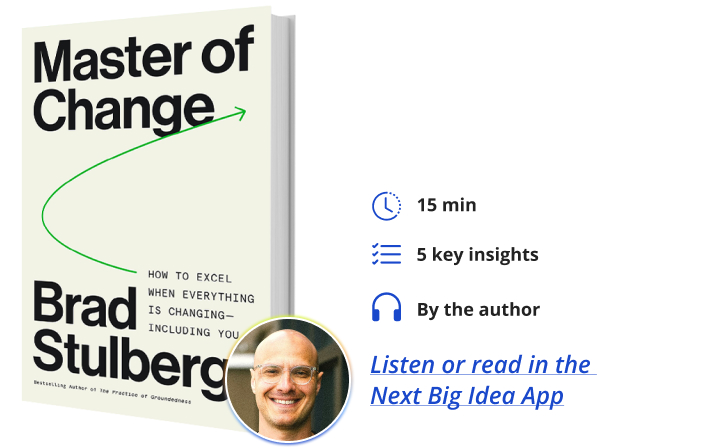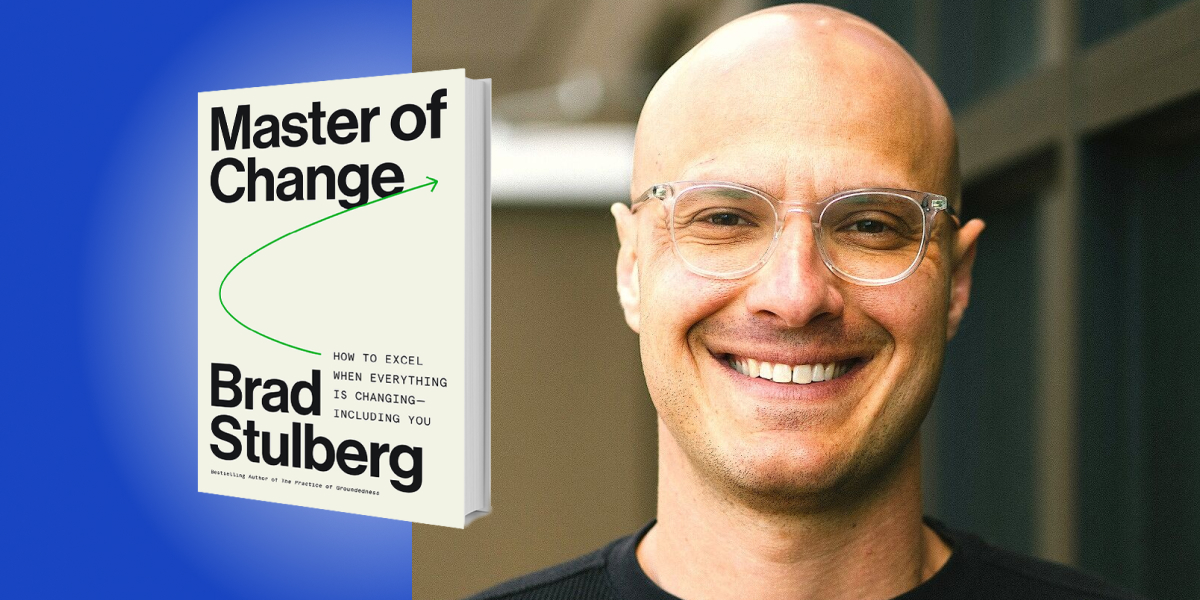Brad Stulberg researches, writes, and coaches on health, well-being, and sustainable excellence. He is the bestselling author of The Practice of Groundedness and co-author of Peak Performance. Stulberg regularly contributes to the New York Times, and his work has been featured in the Wall Street Journal, Washington Post, Los Angeles Times, The New Yorker, Sports Illustrated, Outside Magazine, Forbes, and other outlets. He also serves as the co-host of The Growth Equation podcast and is on faculty at the University of Michigan’s Graduate School of Public Health.
Below, Brad shares five key insights from his new book, Master of Change: How to Excel When Everything Is Changing – Including You. Listen to the audio version—read by Brad himself—in the Next Big Idea App.

1. Develop rugged flexibility.
Studies demonstrate that the more distress—or what researchers call “allostatic load”—a person, organization, or culture experiences during periods of disorder, the greater their chance of disease and demise. Fortunately, the same science agrees that we can also become stronger and grow from change. Additionally, much about how we navigate it is behavioral; that is, it can be developed and practiced.
The goal is not to be stable and therefore never change. Nor is the goal to sacrifice all sense of stability, passively surrendering yourself to the whims of life. Rather, the goal is to marry these qualities and cultivate rugged flexibility. To be rugged is to be tough, determined, and durable. To be flexible is to consciously respond to altered circumstances or conditions, to adapt and bend easily without breaking. Put those together and the result is a gritty endurance, an anti-fragility that not only withstands change but thrives in its midst.
The best way to face change is to know and hold onto your deeply-held core values; these are the characteristics and beliefs that make you who you are. At the same time, you also want to cultivate an open mind, apply your core values and beliefs flexibly, and be willing to adapt, evolve, and grow.
The next time you are faced with change, be it the smaller day-to-day stuff or the more significant disruptions we all face, ask yourself what it would look like to be both rugged and flexible. Unlike old ways of approaching change, rugged flexibility conceives of change not as an acute event that happens to you, but rather as a constant of life, a cycle in which you are an ongoing participant. Via this transformative shift, you come to view change and disorder as something you are in conversation with, as an ongoing dance between you and your environment.
2. Embrace non-dual thinking.
While some things in life truly are either/or, many are both/and. Philosophers call this kind of thinking non-dual. It recognizes that the world is complex, much is nuanced, and truth is often found in paradox and contradiction: not this or that, but this and that. Non-dual thinking is an important, albeit spectacularly misunderstood and underused concept in many facets of life, including when it comes to change.
“Inherent to non-dual thinking is developing wisdom.”
One way to differentiate knowledge from wisdom is that knowledge is knowing something and wisdom is knowing when and how to use it. Inherent to non-dual thinking is developing wisdom, realizing that many concepts and tools work great until they get in your way. As the Nobel-winning psychologist Danny Kahneman used to tell his students, “When someone says something, don’t ask yourself if it is true. Ask yourself what it might be true of.”
3. Update your expectations to match reality.
The human brain functions like a prediction machine that is constantly trying to anticipate reality. You feel (and do) best when your reality is aligned with, or perhaps slightly better than, your expectations. Try to set appropriate expectations, and when unsure, err on the side of being cautious and conservative. If a situation doesn’t unfold as badly as you thought, you’ll be pleasantly surprised. If a situation does unfold as badly as you thought, you’ll be prepared and levelheaded.
When an unforeseen change occurs, do everything you can to see it for what it is and update your expectations accordingly. The longer you hold onto old expectations the worse you’ll feel and the more time and energy you’ll waste when you could be working on what is happening in front of you instead. Here is what I was hoping for or thought would happen. Here is what is actually happening. Since I live not only in my own head but also in reality, I need to focus on the latter.
4. Respond not react.
Skillfully responding to change requires creating space between an event and what you do, or don’t do, about it. In that pause, you give immediate emotions room to breathe and thus you come to better understand what is happening—that is, you process. As a result, you can reflect and strategize using the most evolved and uniquely human parts of your brain to make a plan—and only then proceed accordingly.
To help you pause, label your emotions. To help you process and plan, try one of the self-distancing techniques: giving advice to a friend, practicing mindfulness meditation, or experiencing awe.
The biggest barriers to proceeding are self-doubt and paralysis by analysis. The best way to overcome them is to treat your first moves as experiments. Lower the bar from needing to take the absolutely right or perfect action to trying something new and learning from it. If hindsight proves your actions useful, keep going down the same path. If hindsight proves them unsuitable, adjust course, perhaps repeating the first 3 P’s—pause, process, and plan—before proceeding again.
5. Use behavioral activation to just get started.
Sometimes when we are going through significant changes and feeling stuck and exhausted—emotionally, physically, socially, or spiritually—the best thing we can do is rest. But at a certain point, rest creates inertia. Our minds and our bodies are as recovered as they are going to be. Yet we still feel off. At this point, we can likely benefit from deploying a psychological concept called behavioral activation. First developed in the 1970s by the clinical psychologist Peter Lewinsohn as a way to help people work through depression, apathy, and other entrenched negative states of mind, behavioral activation is based on the idea that action can create motivation, especially when we are stuck or in a rut.
“You simply cannot think or will yourself to a new state of being.”
To be clear, this is not about trying to think positive thoughts, a mantra that became a pillar of the self-esteem movement in the last century, with mega-best-selling books such as 1952’s The Power of Positive Thinking. That form of thinking argued—we now know, falsely—that if you just think positive thoughts and suppress negative ones, you’ll gain health, wealth, and happiness. If anything, research has shown that those strategies often backfire: the more you mentally try to change how you feel, the more stuck in your current mood you’re likely to end up. You simply cannot think or will yourself to a new state of being.
The challenge with behavioral activation is mustering enough energy to start acting on the things that matter to you. When you feel down, unmotivated, or apathetic, give yourself permission to feel those feelings but not dwell on them or take them as destiny. Instead, shift the focus to getting started with what you have planned in front of you, taking your feelings, whatever they may be, along for the ride.
Doing so gives you the best chance at improving your mood. It can be helpful to think of this initial oomph as activation energy. Sometimes we need more, and sometimes we need less. When we are in a rut, even the little things require more, and that’s okay. It may take some extra work to overcome the initial stasis and friction. But the more we get going, the easier it becomes. It’s as if the laws of physics apply to our minds, too. Once we get going and break out of a rut, we can begin to take productive action and engage with change. Change is going to inevitably shape us, but we can shape it too.
To listen to the audio version read by author Brad Stulberg, download the Next Big Idea App today:






























